1850, U.S. Census: total population, 23.19 million; slaves, 3.20 million (16.5%); free blacks, 434,000 (1.9%).
Immigration in 1840s nearly triples to 1.71 million (including 781,000 Irish, 435,000 Germans, 267,000 British, 75,000 Mexicans). Driven by famine in Ireland, failed revolutions of 1848 in Europe, gold in California and Mexican Cession of Western lands.
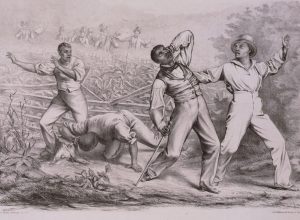 Anti-compromise cartoon.
Anti-compromise cartoon.
1850, Compromise of 1850 is passed, September. California admitted as 16th free state, compared to 15 slave. But future new states in territory won from Mexico are now to determine if they will be free or slave (thus not extending the Missouri Compromise 36o 30” dividing line). Also, second Fugitive Slave Act stiffens laws. Slave trade banned in Washington, DC; but slavery continues.
Seeing such a move coming, Alexandria, a major slave-trade city, won return to Virginia from District in 1846.
Brokered by Clay of Kentucky (Whig) and Stephen Douglas of Illinois (Democrat), and signed by Millard Fillmore (who became president after July death of compromise-opposing Zachary Taylor).
1850, Joshua John Ward is the largest U.S. slave master with 1,092 on his South Carolina rice plantations.
Second is Stephen Duncan, the wealthiest U.S. cotton planter, with almost 1,000 slaves working 15 plantations in Mississippi and Louisiana. Duncan also has extensive banking, lumber, railroad and steamboat interests. Slaves account for half his estimated $3.5 million worth.
Duncan, who supports American Colonization Society, opposes secession in conflict with fellow plantation slave masters. He leaves Natchez in 1863 for New York.
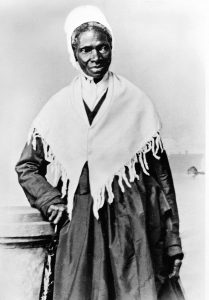 Sojourner Truth.
Sojourner Truth.
1850, Sojourner Truth, born a slave in Ulster County, NY, publishes her narrative. A year later, she delivers her “Ain’t I a Woman” speech to Ohio Women’s Rights Convention in Akron.
1850, A band of 200-plus Seminole (at least half of them Black Seminoles) led by Wild Cat and John Horse, escape the Creek reservation in the Indian Territory and cross Rio Grande into northern Mexico. The Creek had treated free blacks as enslaved and allowed slave traders to hunt them.
Mexicans welcome them as mascogos and arm them against Comanche and Texans. Some Indians eventually return to Oklahoma. Texas Rangers, attempting to destroy the remaining black settlement at El Nacimiento, are repelled in 1855. In 1870, a number of Black Seminoles are invited to join U.S. army’s scouts at Fort Clark, TX; three awarded Medal of Honor in 1875.
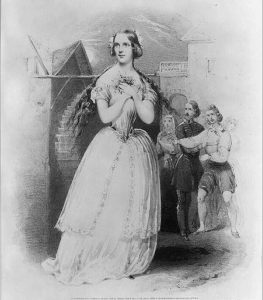 'The Swedish nightingale.'
'The Swedish nightingale.'
1850, Jenny Lind, 29-year-old Swedish soprano sensation, begins two-year tour of U.S. in New York, September. Introductory leg, promoted by P.T. Barnum, goes to Boston, Philadelphia, Washington, Richmond, Charleston, Havana, New Orleans, Louisville, Cincinnati and Pittsburgh.
1850, Cuba passes Brazil as the leader in sugar production, exporting nearly a third of the world total. In addition to vast expansion of slave numbers, planters introduce steam-powered mills that draw still more juice per ton of cane. Narrow-gauge railroads bring the processed raw sugar to Havana and Santiago de Cuba.
Wealthy planters and slave masters dominate the island’s politics.
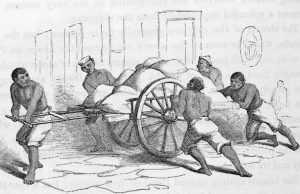
Carting freight in Rio.
1850, Brazil’s parliament moves to definitively ban slave imports, Sept. 4, ending a surge in smuggling of slaves to work booming coffee plantations.
Britain unilaterally enforces this ban by sending anti-slavery patrols into Brazilian harbors to seize slavers; at one point a Royal Navy vessel exchanges fire with a Brazilian fort.
Slavery within Brazil remains legal until 1888.
 State endorses Indian killings.
State endorses Indian killings.
1850, Most of 200 Pomo people gathered on an island in Clear Lake, northern California, are killed by U.S. troops under Lt. Nathaniel Lyon, May 15, including many women and children. This is retaliation for the killing of two white settlers said to have enslaved Pomo.
Such enslavement was effectively made legal by the state’s first legislature’s Act for Government and Protection of Indians, which permits settlers to obtain and hold Indian children for work, April 22.
In 1851, the first governor, Peter Hardemann Burnett, endorses “war of extermination” against Indians. Some counties put bounties on Indian scalps. In 1852, state bugets $1.1 million for militias that hunt Indians.
At least 4,500 California Indians are killed between 1846 and 1873 by miners and settlers individually or by vigilante packs, and by militia and U.S. Army forces. Total violent deaths may be triple that, most of them in the early gold rush years.
California indigenous population estimates: 310,000 in 1770 (arrival of Spanish mission builders); 150,000 in 1830 (before cession to U.S. and the gold rush); 70,000 in 1870. From S.F. Cook.
1850s, British anti-slavery squadrons now count 25 ships with crews totaling 3,000, a third of them blacks from African coastal regions (including Kroomen from Liberia).
From 1808 to 1860, Royal Navy seizes 1,600 slave ships, freeing 150,000 slaves.

Harriet Beecher Stowe.
1851, Uncle Tom’s Cabin; or, Life Among the Lowly by Harriet Beecher Stowe serialized in The National Era. Book published 1852. Only the Bible outsells it in 19th-century U.S. Stowe’s father is a Presbyterian evangelist, brother is Henry Ward Beecher, the abolitionist minister in Brooklyn.
A stage version opens in New York, November; eight “anti-Tom” novels issued by Southern writers before 1852 closes.
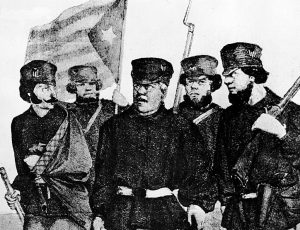 Southern filibuster stopped.
Southern filibuster stopped.
1851, Narciso López, a disgruntled former Spanish official on Cuba, leads several hundred men from the U.S. to the island, hoping to stir up a revolution and ultimately to deliver Cuba as a new slave state to the U.S., August. This, López’s third filibuster attempt, is supported by Mississippi Gov. John Quitman, a leader of pro-slavery Southerners fixated on absorbing Cuba into the union.
López and his men are quickly rounded up. Most are tried and executed, including López and a number of the Americans (in Havana’s Punta Castle) and the rest sent to work in mines.
1851, Slave trade to Brazil is finally, effectively, suppressed in wake of revolt on coffee plantations, a yellow-fever outbreak attributed to imported slaves, steady opposition by Emperor Pedro II, and heightened British pressure (including funding of Brazilian abolitionists and bribing of Brazilian legislators to pass tougher law in 1850, in addition to reinforced naval patrols that aggressively board and seize suspect slavers).
Traffic to the largest slave destination all but ends by 1852. Bondage, however, continues for those already enslaved in Brazil.
Meanwhile, Ecuador goes all the way in abolishing slavery.
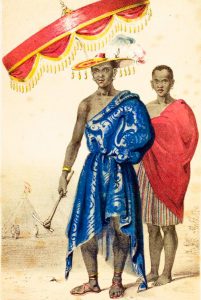 Slave raid turned back.
Slave raid turned back.
1851, In March, Dahomey’s King Ghezo attacks Abeokuta, a city founded in 1825 by Egba people as a refuge from slave raids amid disintegrating Oyo empire. Ghezo seeks captives to enslave. His warriors, including the fierce female Mino, scale city walls but are turned back with heavy losses.
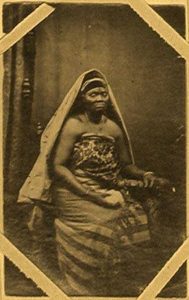 Lagos's Merchant Madame.
Lagos's Merchant Madame.
1851, Royal Navy squadron bombards Lagos (Nigeria), Dec. 26-28, and British replace pro-slave trade ruler Kosoko with previous leader, Akitoye, who signs treaty to end slave trading (and human sacrifice), Jan. 1.
Madame Efunroye Tinubu, a leading merchant, works behind scenes to continue slave trading with Portuguese merchants. She also supports uprising against growing Saro and Amaro communities who begin to dominate legitimate trade with British.
The Saro are mostly Yoruba and Igbo peoples (and their descendants) freed from slave ships by British patrols and originally taken to Sierra Leone. The Amaro are slaves freed by new governments in Spanish America.
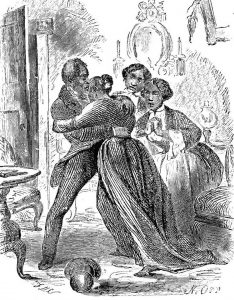 Illustration from the book.
Illustration from the book.
1852, Twelve Years a Slave by Solomon Northrup is published in New York, dedicated to Harriet Beecher Stow. It tells of Northrup’s free birth in Saratoga Springs, NY, his kidnapping in Washington, and his bondage on Red river plantations in Louisiana.
1853, Mexican Pres. Santa Anna agrees to sell to the U.S., for $10 million, 30,000 square miles of what is now southern Arizona and New Mexico, between El Paso, TX, and Yuma. Pres. Franklin Pierce and U.S. minister to Mexico James Gadsden (originally from Charleston, SC) want it for a transcontinental railroad route that would benefit Southern ports.
That railroad, the Southern Pacific, is finally opened between Houston and Los Angeles in 1883.
1853, Bloody slave uprising in Portugal’s Cape Verde Islands is suppressed. Details are not easily found, but it helps generate a movement to more easily free children of slaves.
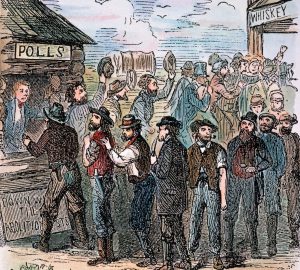 Pro-slavery voters.
Pro-slavery voters.
1854, Kansas-Nebraska Act effectively replaces Missouri Compromise with principle of “popular sovereignty,” with citizens determining status of slavery in territories gained from the Louisiana Purchase, ending the absolute ban on slavery north of 36° 30”.
The bill also advances a northern route for a transcontinental railroad, which attracts some Northern support.
After months of fierce national debate, Democratic majorities pass it 37-14 in Senate and 113-100 in the House. Pres. Pierce signs it May 30.
Suddenly, extension of slavery is possible to far more U.S.-held territory.
The law quickly triggers violence in Kansas between pro-slavery and Free-Soil forces, the latter opposing slavery, in part because it would undermine poor, non-slave farmers in favor of large planters.
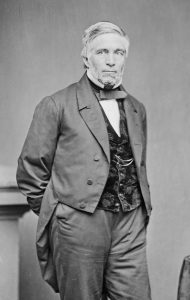 First Republican governor.
First Republican governor.
1854, In response to Kansas-Nebraska Act, Republican Party is launched by dissatisfied Northern Whigs, Northern and border-state Democrats, Free Soilers, and abolitionists.
Nearly 10,000 people gather in Jackson, MI, July 6, to nominate candidates for governor, state legislature and Congress.
First platform calls for exclusion of slavery from all federal territories, July 6. Anti-slavery voters quickly follow suit in Wisconsin, Illinois, Pennsylvania, Vermont, Massachusetts and Maine.
Kinsley S. Bingham, a leader of the Jackson meeting, is elected governor of Michigan, the first Republican to win any governorship.
Other Republican victories in Northern states helps to end Democratic and Southern majority in House in November.
 Teacher Elizabeth Jennings.
Teacher Elizabeth Jennings.
1854, Elizabeth Jennings, a black teacher at New York’s African Free School, is ejected from a segregated horse car, July 16. She wins support of prominent blacks, including Frederick Douglass, goes to court and wins a jury award of $250. Chester A. Arthur, a future president, argues her case.
The losing company immediately desegregates all cars. This leads to desegregation of all public transit services in the city by 1865.
1854, In the Ostend Manifesto, three U.S. ministers in Europe (including James Buchanan in London) propose the purchase or forcible annexation of Cuba. Many Southerners project Cuba would join Union as a slave state.
Manifesto also argues that annexation would forestall “Africanization” of Cuba, Haiti-style.
But Northern and European opposition forces Pres. Pierce to relent.
1854, George Fitzhugh’s Sociology of the South, or, The Failure of Free Society asserts that the South’s enslaved enjoy better lives than the relentless wage competition impoverishing “free” laborers of the capitalistic North and of Europe.
He suggests slavery actually comes far closer to delivering on the Marxian promise of “from each according to his ability, to each according to his needs.” He asserts that Jefferson’s ideal of “equal rights” are contradictory to the natural order, but he also says slavery should be extended to benefit poor whites as well as blacks.
 Steam gins produce cotton.
Steam gins produce cotton.
1854 and after, Large steam-driven cotton gins are processing 4,000 pounds a day, 80 times as much as Whitney’s original hand-driven gin. Plus, steam presses are more quickly compacting the 500-pound bales for shipment.
But cotton planting, cultivation and picking are not mechanized until the 20th century. Mass “stoop labor” is required for decades.
1855, Portugal adopts law that children of slave women born in colonies will be free upon Catholic baptism and compensation to slave master. This in the wake of the 1853 uprising.
On Cape Verde Islands, godparents will frequently put up the 200 reals.
1855, Cholera epidemic reaches Puerto Rico, November. More than 26,000, 5.4% of the population, die before it subsides in December 1856. Spanish government later promotes immigration of thousands to Puerto Rico from Canary Islands.
Brazil and Venezuela are also hit, both for the first time, with Brazil suffering more than 160,000 deaths, with slave and mixed-race populations particularly devastated.
 Ruins of the Free State Hotel.
Ruins of the Free State Hotel.
1856, Lawrence, KS, center of Free Soil anti-slavery community, sacked by pro-slavery mob, which dumps the press and type of the Herald of Freedom newspaper, and burns down the Free State Hotel and homes of leaders, May 21. However, only one person dies.
 Attack of Charles Sumner.
Attack of Charles Sumner.
1856, In his “Crime Against Kansas” speech the next day, Sen. Charles Sumner (Massachusetts) calls Kansas-Nebraska Act ”rape of a virgin territory” and charges Sen. Andrew Butler of South Carolina with taking “the harlot, Slavery” as a mistress, May 22.
Two days later, South Carolina Rep. Preston Brooks, a cousin of Butler’s, beats Sumner nearly to death in the Senate chamber. Many Southern Democrats voice support of Brooks; Northerners are outraged. Sumner is unable to return to his Senate duties until June 1860.
 Attack on Harper's Ferry.
Attack on Harper's Ferry.
1856, John Brown, advocating violent action to end slavery, is joined by his sons and other followers in raiding settlement on Pottawatomie Creek, KS. They seize five pro-slavery men in their homes and hack them to death with swords, May 24.
More than 250 Border Ruffians attack Free Soil town of Osawatomie, KS, Aug. 30. They run off Brown and 40 Free Soil defenders, killing five, including Brown’s son, Frederick. The town is looted and burned.
1856, Frederick Law Olmsted’s multi-year survey of the South’s slave economy is issued in book form (after running in The New York Times). He reports that no more than 8,000 plantation masters derive significant profits from slave system, and that most white workers are considerably worse off than their Northern counterparts.
 James Buchanan.
James Buchanan.
1856, Democrat Buchanan (Pennsylvania) elected president over John C. Frémont, first Republican presidential candidate, who does well in Midwest, New York and New England. Know-Nothing (anti-immigrant party) Fillmore comes in third, Nov. 4. Democrats take back House.
Incumbent Pierce lost nomination to Buchanan because of his unpopular (in Northern states) support of pro-slavery groups in Kansas.
1856-1858, Skirmishes and raids break out between remaining Seminole bands in central Florida and pressing white settlers and militia. Troops destroy Seminole towns and crops in Big Cypress Swamp and offer cash payments ($500 to warriors, $100 to women) to accept removal to Indian Territory. Facing starvation, most do, but several small, family bands withdraw into Everglades. Their descendants eventually receive tribal recognition and reservation lands, which they hold to this day.
 Dred Scott.
Dred Scott.
 Roger B. Taney.
Roger B. Taney.
1857, Supreme Court, in 7-2 Dred Scott vs. Sandford decision, finds blacks—slave or free—cannot be citizens of the nation or of any state and thus have no standing in federal courts, March 6. Decision goes on to strike down entire Missouri Compromise as an unconstitutional limit on slavery.
Abolition forces in North are outrage. It's another step toward conflict.
Note: Chief Taney and two other justices who ruled in favor of slaves in Amistad case rule against Scott here. Justice McLean ruled for both Amistad slaves and Scott.
Scott and family are freed in May by Taylor Blow, son of their original owner.
1858, Minnesota admitted as 17th free state, compared to 15 slave. Republicans win a plurality in the U.S. House for the first time, in mid-term election.
 John Butterfield's stagecoach.
John Butterfield's stagecoach.
1858, John Butterfield’s Overland Mail Company begins transcontinental stagecoach and mail service between St. Louis and Memphis in the east and Los Angeles and San Francisco in the west, September. Departures are twice weekly, stopping only to change horses or mules. Trip takes 25 days via snow-free southern route with stops at El Paso and Tucson (the latter within the five-year-old Gadsden Purchase).
The service operates until the eve of war; proposals to open a more northern route fail.
 Slave ship en route to Georgia.
Slave ship en route to Georgia.
1858, More than 409 slaves are smuggled from the mouth of the Congo, to Jekyll Island, GA, aboard Wanderer, a large racing yacht, Nov. 28. Another 75 slaves die on voyage. Ship had departed New York for Africa (via Charleston) flying the flag of the New-York Yacht Club.
Slaves are quickly sold, but Wanderer’s owners, including Charles A.L. Lamar of Savannah and William C. Corrie of Charleston (who also captained the ship) are subject to federal trials in Savannah. These end in mistrials or acquittals, May, 1860. Outrage in North adds to sectional tensions.
Wanderer is seized by Union Navy early in the war and serves in the blockade and as a hospital ship.
1858, Portugal abolishes slavery in colonies, including Cape Verde Islands, Guinea, Angola and Mozambique (but not in Brazil, which is now independent).
However, all slaves are subject to a 20-year apprenticeship to 1878.
1859, Oregon joins the Union as 18th free state, compared to 15 slave.
Southern leaders see their strength in the Senate slipping away.
1859, More than 435 men, women and children are sold at the Ten Broeck Race Course near Savannah in what is believed to be the largest single slave auction in U.S. history, March 2-3. The seller is Pierce Mease Butler who has lost most of a huge inheritance from his grandfather, a Revolutionary War officer and a leading Southern delegate to the Constitutional Convention.
The slaves worked the Butler family’s extensive rice and cotton plantations on Butler and St. Simons islands, respectively.
Butler was married to Fanny Kemble, a famed British actress and writer, who was shocked by conditions on the plantation. In 1863, long divorced, she described that experience in graphic terms in her book, Journal of a Residence on a Georgian Plantation in 1838-1839, which quotes slaves extensively.
1859, “Dixie” is performed for first time, April 4, in New York by Bryant’s Minstrels, a blackface group including songwriter Dan Emmet. After it becomes the Confederate marching song, pro-Union Emmet writes a fife-and-drum manual for Union army.
1859, In a compact edition of his Impending Crisis of the South, issued in July, Hinton Helper attacks slavery on economic grounds, describing a South that as fallen woefully behind the free states. Helper’s copious charts and tables (based on U.S. census and state data) are deemed highly effective.
With help from Horace Greeley and other abolitionists, more than 150,000 copies are quickly distributed to the delight of the abolitionists and the fury of white Southerners. Possession of a copy is treated as a criminal offense in many slave states.
Helper, a North Carolina native, dedicates the book to non-slaveholding white Southerners. But he is no friend to blacks, later proposing their expulsion to Africa or Latin America.
 John Brown prepares for hanging.
John Brown prepares for hanging.
1859, John Brown leads raid on U.S. arsenal at Harper’s Ferry, VA. The 21 men, including five blacks, plan to seize weapons and inspire a general slave uprising. Although people are killed, including two of Brown’s sons, the uprising doesn’t happen; militia and U.S. Marines under Robert E. Lee take Brown and followers into custody, Oct. 18. Brown and seven others are tried, hanged, Dec. 2.
Well-known Boston abolitionists, including Garrison, provided financial aid for the raid; Harriet Tubman helped gather volunteers. Frederick Douglass voiced major reservations when Brown conferred with him that summer.
In death, Brown is widely lauded in the North as an anti-slavery hero, not least among black populations. In the South, he is vilified as a murderous instigator of black rebellion.
 Gold miners' tents in Virginia City.
Gold miners' tents in Virginia City.
1859, Gold, and then silver, is found on the east slope of Mount Davidson in western Nevada. Word gets out in June and a new rush for riches is on. Virginia City is soon established as the main boomtown. While $700 million worth of gold and silver is taken out of the ground by 1919, most mines don’t pay.
